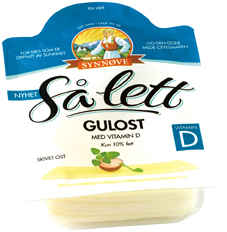
With an avalanche of scientific support on the benefits of vitamin D, scientists are now proposing an increase in the recommended daily intake
GLUTEN-FREE products in the market continuing to rise globally, with a further double-digit growth recorded in 2009 to take the total number recorded on the Innova Database to more than double the level in 2007. This is partly due to improved labelling regulations, but also due to rising awareness of gluten intolerance and the search for more mainstream and good-tasting gluten-free products across a range of food and drinks sectors. Recently, bone health has gained immense significance amongst consumers throughout the world. According to the International Osteoporosis Foundation, fracture as a result of osteoporosis occurs every 30 seconds, and with an aging population, the yearly incidence of hip fracture alone in Europe is expected to more than double from approximately 500,000 to 1,000,000 over the next 50 years. In the United States, with more than 44 million Americans suffering from osteoporosis (Source: National Osteoporosis Foundation), it is apparent that bone health is one of the well-established and most popular segments amongst consumers. The key ingredients in this sector can be classified as those ingredients that directly impact the bone health and those that indirectly aid in maintaining bone health. The most recognised and established ingredients, such as calcium and vitamin D, fall under the first category. Both calcium and vitamin D have a long history of safe use in the market and benefit from strong consumer awareness. In addition, ingredients such as prebiotics and soy isoflavones indirectly aid the maintenance of bone health. These ingredients are complementary to calcium and vitamin D, and function by the way of either enhancing absorption or by reducing the loss of minerals in the body. Beyond bone health While vitamin D is renowned for its bone health benefits, it is increasingly evident that the benefits offered by this ingredient are not limited to the aforementioned. Traditionally, vitamin D always piggy-backed on the credentials of calcium as it is a nutrient that is required for the proper absorption and utilisation of calcium. Thus, any bone health product in the market with calcium would also include vitamin D in it. Since early 2000, however, the nutraceuticals industry started witnessing influx of science supporting the distinct benefits of vitamin D. The growing array of health benefits of vitamin D includes prevention of fall and neuromuscular function, improved immunity, insulin response and gastrointestinal health. Fall prevention, which is a major risk factor for those with osteoporosis, is one of the critical benefits conferred by the vitamin. In addition to the expanding portfolio of health benefits, a growing number of scientific evidence is demonstrating the prevailing deficiency of this crucial vitamin. In fact, recent studies suggest that the rate of vitamin D deficiency in the United States and Europe is on a steady high. Adding credence to the statistics is the recent demand of the scientific community to revise the daily intake values of vitamin D. With an avalanche of scientific support on the benefits of vitamin D intake, scientists are now proposing an increase in the recommended daily intake (RDI) to 2000 IU, which is yet to receive the much needed regulatory approval. In addition, companies like Kraft have petitioned for an increase in the amount of vitamin D to be added to their foods.  Dynamic marketplace The vitamin D market has been witnessing an upswing due to the growing focus on the vitality and prevailing nutritional gap of this vitamin. Endorsements by celebrities, media, generHomme
Dynamic marketplace The vitamin D market has been witnessing an upswing due to the growing focus on the vitality and prevailing nutritional gap of this vitamin. Endorsements by celebrities, media, generHomme
 iConnectHub
iConnectHub
 Login/Register
Login/Register Supplier Login
Supplier Login


























